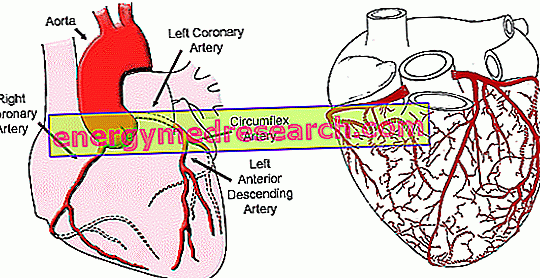Coronary circulation: structure and functions
The coronaries are arteries deputed to spraying and nourishing the heart, to which they supply an adequate quantity of blood to the metabolic demands. The name of these medium and small caliber vessels (3-5 mm in diameter) derives from their particular distribution around the heart muscle, which surrounds composing a sort of arterial crown.
The coronary arteries are two and take the name of left coronary artery and right coronary artery. Both originate from the ascending aorta, just above the aortic or semilunar valve (they are the first arteries that originate from the aorta), and run on the outer surface of the heart. More precisely, the left coronary artery originates from the left aortic sinus, while the right coronary artery from the right aortic sinus . While the left coronary artery divides into two large branches - the anterior or intraventricular descending branch and the circumflex descending branch - the right coronary artery, apart from the collateral branches to which it gives rise, remains undivided along its entire course. It should be emphasized that the precise anatomy of the coronary circulation varies considerably from person to person.
The coronary arteries that run on the external surface of the heart are called epicardial coronary arteries, while the vascular branches that penetrate deeply are called endocardial coronary arteries.

Although the peripheral distribution of the coronary arteries is essentially terminal, between the various terminations there are small bridges (anastomoses) which - in the presence of coronary stenoses (atherosclerosis) - can be amplified to constitute real collateral circles. For an adequate development of anastomoses to occur, it is important that the increase in obstruction (atheroma) is slow and gradual. Also the physical exercise constitutes a very important stimulus for the development of these secondary circles.
When the metabolic demands of the myocardium increase, the coronary arteries can multiply their reach up to four or five times; there is therefore a sort of "coronary reserve", to which the heart can draw - for example - in conditions of physical activity, fever or anemia. Also for this reason, a healthy heart can bear very heavy work increases without any particular problems.
The exhausted blood drained from the heart, poor in oxygen and nutrients, is conveyed, through the coronary veins, to the right atrium, to the ipsilateral ventricle and finally to the lungs.
Coronary artery disease and coronary artery disease
See also: Coronary heart disease drugs
Coronary artery disease, also called coronary artery disease, is a condition in which the arteries of the heart are obstructed by cholesterol deposits and blood clots. These diseases are part of the broader group of cardiovascular diseases and contribute to making them the leading cause of death in the world.
| coronary artery disease | Generic coronary artery disease |
| Ischemic heart disease | Coronary narrowing, which causes insufficient blood supply to the heart |
| Heart attack | Death of an area of cardiac tissue following prolonged interruption of the heart blood port |
During the course of life the coronary arteries may develop narrowing (or stenosis) due to the growth of atheromatous plaques (deposits consisting essentially of lipids, platelets, smooth muscle cells and white blood cells, which are formed in the inner lumen of medium and large caliber arteries ). When the extent of coronary narrowing exceeds 70%, the blood supply to the heart in working conditions becomes insufficient; one speaks in these cases of cardiac ischemia. Depending on the degree of stenosis, coronary occlusion can cause a temporary state of cardiac distress (ischemia - angina pectoris), up to the necrosis of a more or less extended part of the heart (myocardial infarction). Even small coronary obstructions can be very dangerous; in the event of breakage, in fact, the rapid formation of a blood clot at the level of the plaque (thrombus) can completely occlude the coronary (thrombosis), causing a heart attack.
The health of the coronary arteries can be investigated by an examination called coronary angiography, in which a radio-opaque dye is introduced into the myocardial arteries, which allows to highlight - by means of a dynamic x-ray - possible narrowing. Another technique called scintigraphy allows the detection of possible ischemic areas, thanks to radioactive substances that are fixed to the various areas of the myocardium in inverse proportion to the blood perfusion.
When the coronaries are severely compromised by atherosclerosis, it is possible to intervene with surgical by-passes or to exploit a minimally invasive technique called angioplasty.



